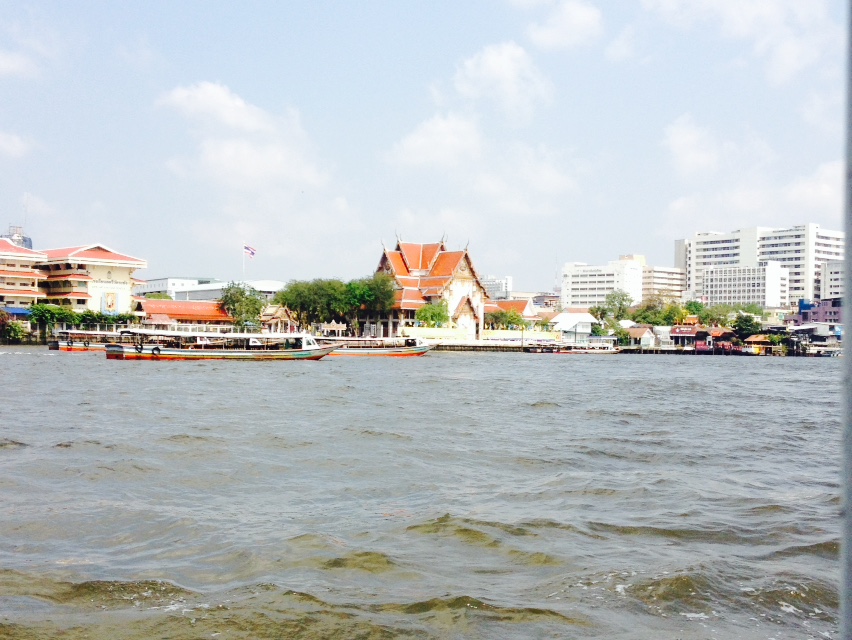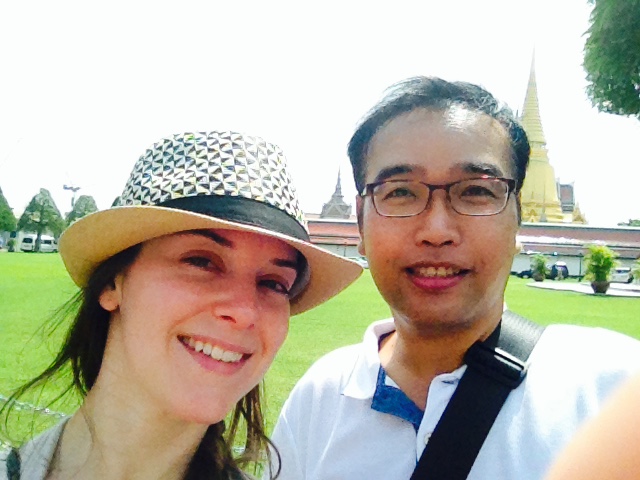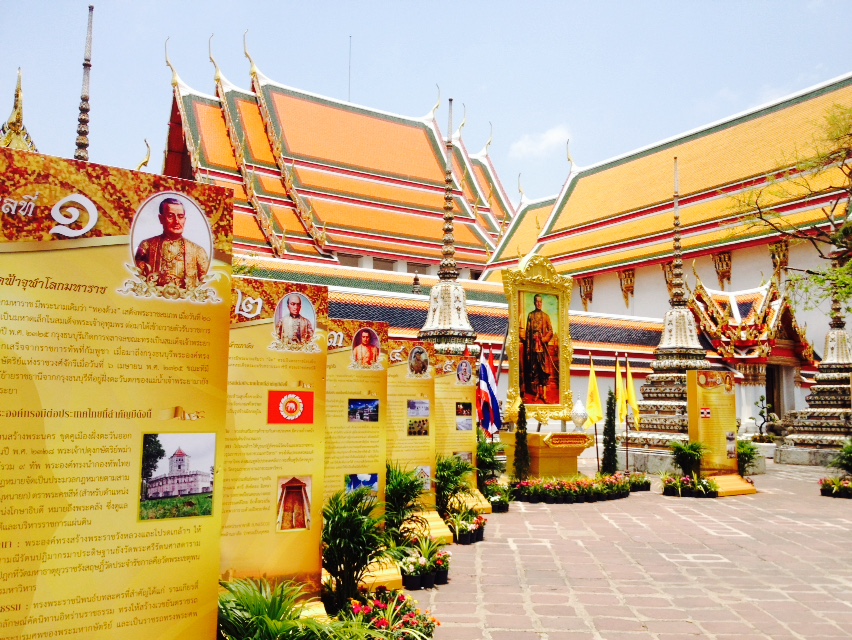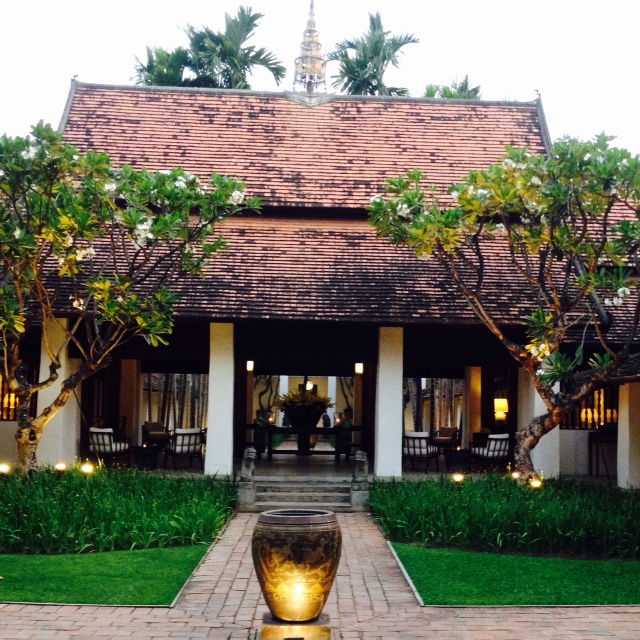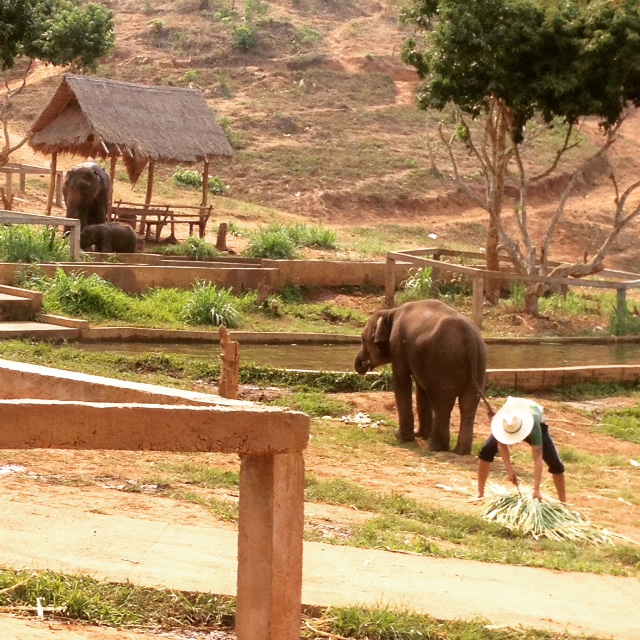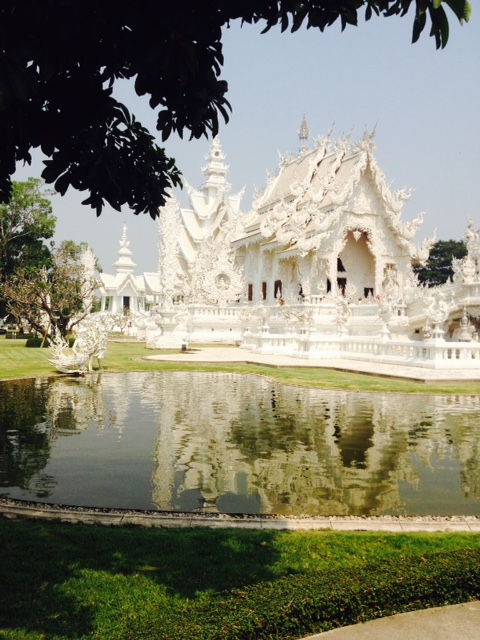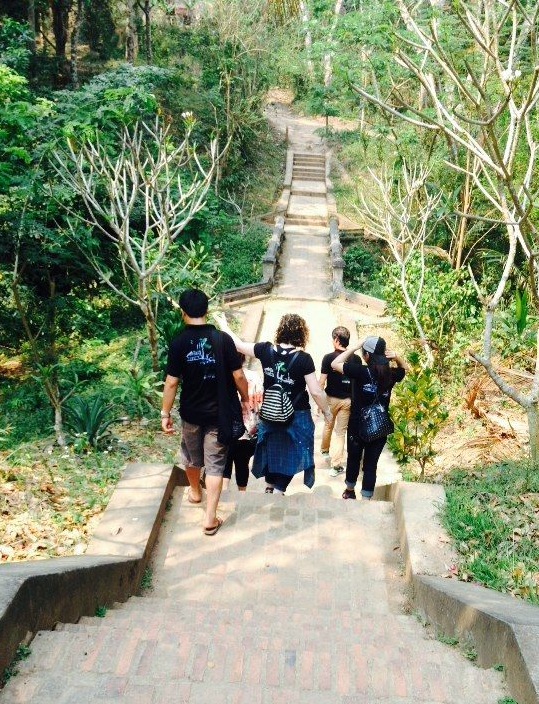
Journeys Within is on our annual inspection tours this spring and traveled on from Thailand to Laos. Read about our recent experiences in our last update On Tour With Journeys Within: Bangkok, Chiang Mai, and Chiang Rai, Thailand to learn about some of our guests’ favorite tours in Thailand.
Follow our journey for updates and travel tips on some of our key locations and tours throughout this spring, and get inspired for your own next adventure.
For travelers who seek to acquaint themselves with highlights of Northern Laos, these Journeys Within tours are ideal:
Days 1-2: Pakbeng to Luang Prabang: Luang Say Cruise and Lodge
Day 3: Luang Prabang Temples and Villages on the Mekong
Day 4: Luang Prabang: Morning Alms, City Tour, and Kuang Si Waterfall
These tours are customizable to the guest’s preferences and schedules, though Journeys Within can make recommendations on the best timing to schedule certain tours and activities to beat crowds and the sun on hot days.
Day 1-2: Pakbeng to Luang Prabang: Luang Say Cruise and Lodge
My final morning in Thailand I departed early from Chiang Rai by van and drove through the countryside to Pakbeng. The scenic drive includes spanning views of green rice fields and tropical trees, shrouded in a layer of morning mist, with occasional thatched-roofed huts and small temples.
This drive provides visitors a peek into the lives of farmers and daily life for people who live in nearby villages. Monks dressed in orange walk through villages for morning alms, and occasional colorfully woven flags can be seen along village roads that indicate to passersby there is a celebration in town, and all are welcome.
Upon arrival in Pakbeng, I was escorted by my guide to immigration at the border of Thailand and Laos. Visitors obtain their visas, and are greeted by Luang Say staff. The staff provides guests name tags that identify they are traveling with Luang Say, and then wait to be transported to the Luang Say Cruise, first by a short van ride then a short bus ride.
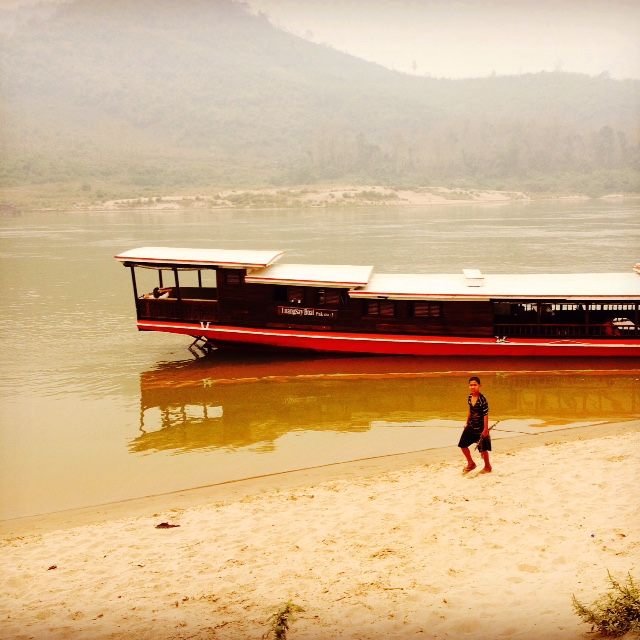
Luang Say Cruise boats are quaint 34-meter wooden riverboats. Guests relax in rattan chairs or lounges at either end of the boat, and get acquainted with their fellow travelers as they cruise down the Mekong River. The riverboat provides a shaded, breezy means of transportation to Luang Prabang as guests watch villagers and water buffalo pass by along the way. The staff of the Luang Say Cruise is gracious, often refilling water glasses and treats such as fresh fruit, banana chips, and tamarind. A home cooked traditional Laotian lunch is provided, including Lao sausage (a Laotian specialty) and cooked meat, fish wrapped in banana leaves, vegetables, and rice.
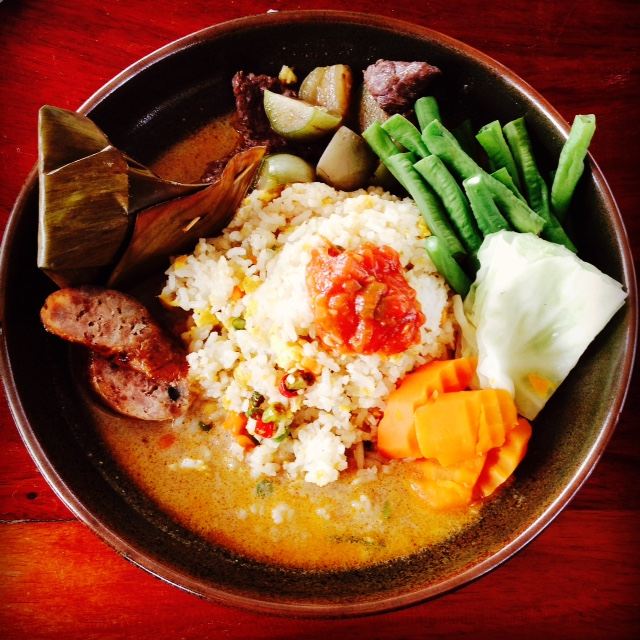
A scheduled stop on the first day of the cruise includes a small village along the river known as Khmu. The tribe originated in India and the people relocated to their current location in 1995. The tribe now consists of 85 families (about 500 people). They farm crops including rice, corn, and hops. Modern advances in the village include running water, electricity, roads, support from Red Cross, and a school that is now five years old. Visitors walk through the village, guided by Luang Say staff, and learn about the way of life for these humble people.
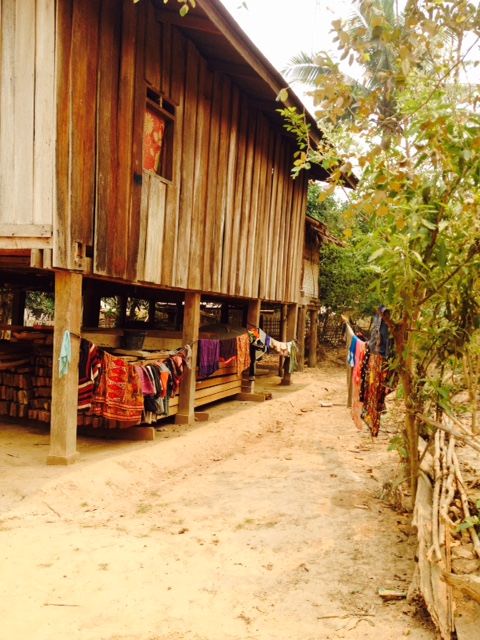
Remember to ask your guide questions, being inquisitive is what enhances these unique tour experiences. Also, it is tempting to take photos of the tribal people and their children, but still polite to ask first. You can also ask your guide to ask people and the parents of children for permission prior to taking photos. These people are gracious to welcome visitors and it is a display of respect to request their images before taking such liberties.
Guests are welcomed with cool drinks upon arrival at Luang Say Lodge. Upon check in to individual private pavilions, guests find their accommodations complete with wood shutters that open to views of the Mekong and mosquito nets over the bed. Each guest room is beautifully appointed in teak wood finishes and made up in crisp white linens, providing a rustic and tidy feel. Insider tip: Luang Say Lodge offers complimentary next-day laundry service to its guests. Not many people know about this, so take advantage!
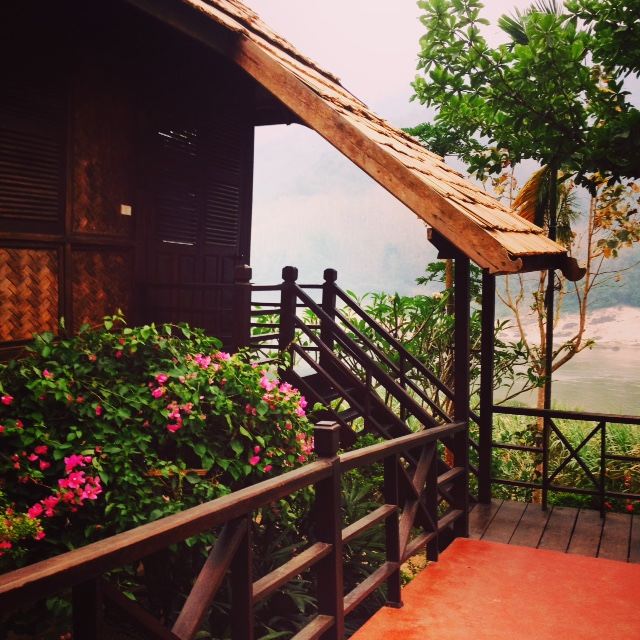
The evening at Luang Say Lodge is a lovely time to stroll around the lodge’s long deck and take photos of the property’s distinct architecture. Multiple sitting areas and an organic vegetable garden are found along the way. The lodge hosts an outdoor traditional Laotian song and dance performance. Some of the guests are even invited to join in the dancing, including me!

Guests who stay at Luang Say Lodge enjoy some genuine time in a locale that is truly secluded. This is an ideal opportunity to ‘switch off’, as limited internet is available only in the main lobby, not the guest rooms. The guest rooms maintain their rustic feel with the absence of television sets. It is truly an experience to spend an evening without attention focused on electronics and, quite literally, leaves guests to their own devices for amusement. Pretend like it’s the 90s again… bring a game, deck of cards, or a good book – a tablet with movies already downloaded, if you must.
A buffet is served the next morning and guests depart for the second and final leg of the journey down the Mekong. One scheduled stop includes Ban Baw Village. While there are no handicrafts available for sale at Khmu Village the first day, there are wonderful goods to purchase at Ban Baw. I did not bring any money with me for our walk through Ban Baw-do not make this mistake. Visitors see how traditional rice alcohol is made and it is also available for purchase for roughly fifty cents for one six-ounce bottle. This alcohol is also sometimes referred to as “LaoLao”. It is stronger than saki, and it is delicious. Also, many textiles are available for sale, such as scarves, blankets, and stuffed animals. Insider tip: Ask your guide to help you distinguish which textiles are factory-made and which textiles are locally-made. The factory-made textiles are also attractive, but it is best to support locally-made textiles from the village. Children sell colorful silk bracelets along the river as the Luang Say Cruise arrives on the riverbank. The bracelets cost less than one US dollar and make for great souvenirs.
Another stop along the river includes the Pak Ou Caves ‘Tham Ting’ and ‘Tham Phoum’, which house thousands of Buddha statues. Make an offering of flowers and incense to one of the Buddhas, along with a good intention, and explore these small caves. Please remember to dress and behave respectfully while visiting the caves. While the caves are not religious temples, the image of Buddha is sacred.
We continued down the river and I was met by my guide in Luang Prabang, then driven to the main part of town for an orientation tour and dropped off at my hotel, Luang Say Residence, to refresh for dinner.
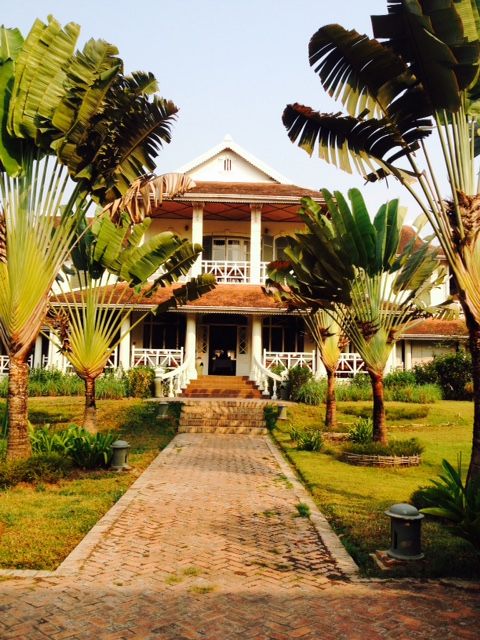
One tour option for guests that is built as a package includes the Luang Say Cruise, Luang Say Lodge, and Luang Say Residence. Luang Say Residence is a gorgeous French Colonial style accommodation with a grand bar and restaurant located in the main residence and five guest pavilions situated on the large, lushly landscaped property. To stay at Luang Say Residence feels as if to be transported back in time, with white lattice accents and antique style furnishings. Ask one of our tour consultants about Luang Say packages. Different packages are available up and down river and are customizable.
What to wear for this tour:
Breathable clothing
Hats, sunscreen, and insect repellant while stopping along the river
Sandals or walking shoes
Day 3: Luang Prabang: Temples and Villages on the Mekong
What better way to further explore the wonders of the Mekong than by riverboat? We make an early start on this tour, crossing the river from Luang Prabang to Xieng Mien on a shaded longtail boat. This means of transportation is efficient in taking guests from place to place.
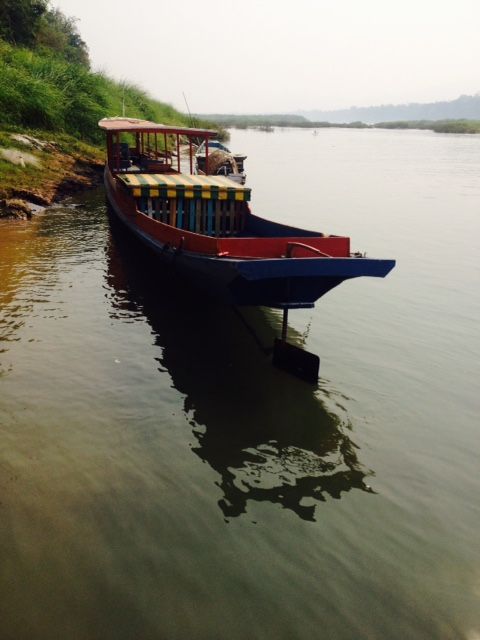
Guests on this tour should be prepared to climb flights of stairs and some small hillsides. However, this tour offers sanctuary for the soul with nature walks and visits to several historic wats (temples). Very few tourists can be found in this area at any given time, so it’s a good opportunity to see special parts of Laos in peace and quiet. Monks reside in parts of this area and can be seen dressed in their orange orange robes and going about their day.
Upon return to the longtail boat we continued down river visited a local fisherman for a Lao-style fishing lesson, using only nets. Some guests may join the fisherman in his boat for an up close look.
A fresh cooked traditional lunch is served aboard the longtail boat-bring your appetite! Lunch is a generous spread of chicken, curry, soup, and other treats made by the boat captain’s wife.
Another hidden treasure we visited on this day is Ban Jan, a pottery village that produces all sorts of wonderful clay goods. Again, do not forget to bring some money with you while visiting this village. Ban Jan offers unique hand made souvenirs, and it can’t get any more authentic than to purchase goods straight from the artisans. Visitors may also see artisans at work, expertly creating a new pot or figurine from start to finish.
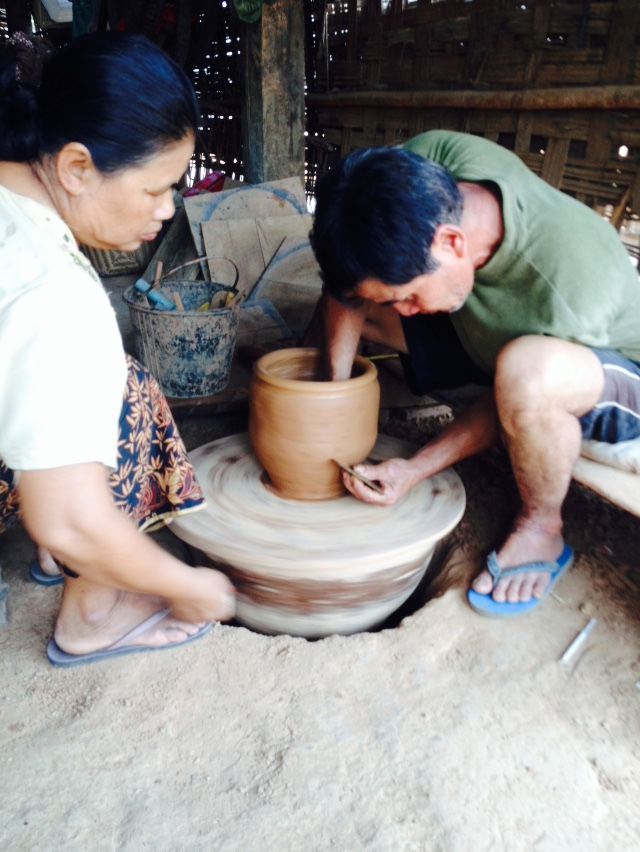
The tour ends with a Lao baci ceremony hosted by the village chief and elders of the community. Buddhists believe that the body is comprised of 34 souls, and the baci ceremony calls all souls back to the body that may have gone missing. The village chief chants and asks the spirits to bare witness as the visitors take part in the ritual. The ritual consists of exchanging food and drink, and villagers tie white strings around each wrist of the guest while offering good intentions of health and prosperity. The strings would traditionally remain on the wrists of the wearer until they fall off naturally, but in modern times, people wait three days and then untie (not cut) the strings, so as to not break the spirit.
The villagers are exceedingly warm and kind. The baci ceremony is a special experience to share with loved ones to commemorate a special occasion, or simply, for the experience itself.
What to wear for this tour:
Breathable clothing, with the knees and shoulders covered for entering temple sites
Walking shoes, no sandals
Sunscreen and insect repellant
Day 4: Luang Prabang: Morning Alms, City Tour, and Kuang Si Waterfall
The earliest start yet in this series of tours was this day at sunrise, and with good reason; to meet the local monks as they walk about town for mornings alms. This ancient Buddhist ceremony is the way in which monks break their fast every day.
My guide took me and my colleague and travel companion, Naida, to a spot set up for us to properly take part in the ceremony. We tied traditional scarves around our shoulders and sat on a blanket with pots filled with fresh-cooked rice. We scooped portions of rice from our rice pots into the food pots of the monks as they passed by and opened their lids. As simple as this process sounds, it is a wonderful experience to make a meaningful interaction, one that I’ll never forget. Our guide was sure to take some photos for us.

An added bonus to the day was an annual elephant parade through town for the Lao New Year, Pi Mai. We got to see several elephants walk through a small section of town, and spectators had the opportunity to feed them sugar cane.
We returned to our hotel for breakfast, then moved on to visit the National Museum. The museum is a former palace with its rooms staged and preserved as they were once lived in by royalty. This is an interesting opportunity to see the fine craftsmanship of vintage furniture, garments, jewelry, paintings, and gifts to the royal family from other countries over the years up close. Visitors may also visit the royal automobile garage which showcases some of the cars gifted over the years, including an Edsel from the US-pause for reaction.
We continued on to see the beautifully ornamented temples of Wat Sen, Wat Xieng Thong, Wat Visun, and Wat Aham. Our guide told us the stories behind the temples’ decoration, and we came face to face with wood-carved Buddha statues over a thousand years old.
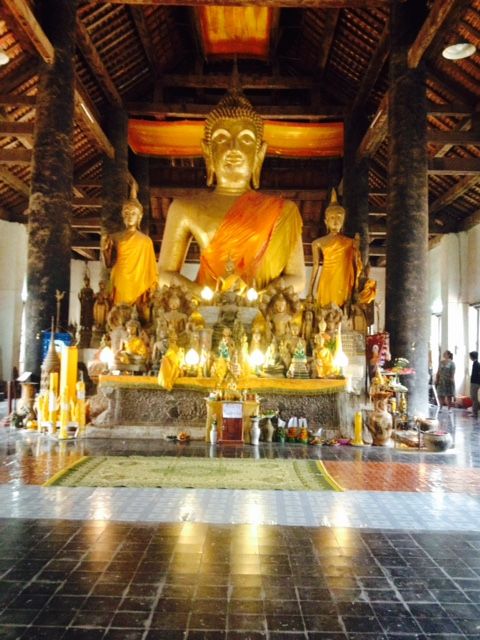
Our next destination, Ock Pop Tok Living Craft Centre, is a veritable textile institute that includes a hotel, restaurant, workshop, instruction space for weaving classes, and an exhibition for antique textiles. We had the pleasure of meeting founders Joanna Smith and Veomanee (Veo) Douangdala, who shared with us the story of Ock Pop Tok’s evolution.
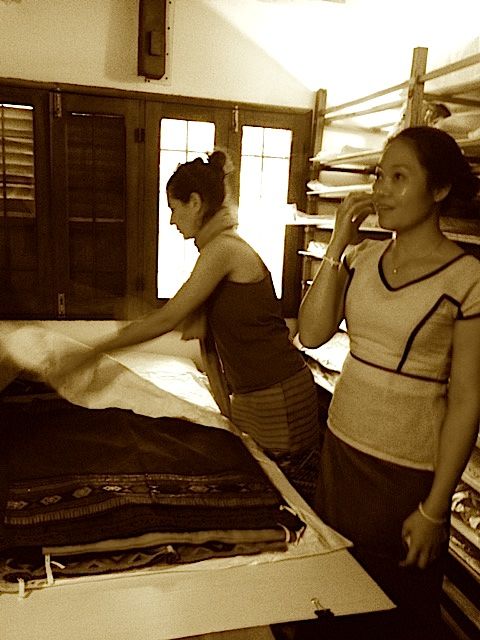
The concept began as a small public showspace that featured unique collaborative pieces created with Veo’s knowledge of traditional Laotian weaving and Joanna’s formal education in fine arts. The result; vibrant textiles that represent the intersection of historic culture through the modern interpretation of two creative minds. The first tour group to visit the show space bought nearly all of their textiles.
Joanna and Veo designed their first official collection and eventually relocated the show space to their current location in Luang Prabang they established ten years ago. The evolution of Ock Pop Tok’s expansion is the result of their collective response to fulfilling the needs they identified in their market and in the preservation of their craft. They began to offer weaving classes by popular request. The weavers on staff also prepared lunch for the students in the weaving class. The response to the food was so positive, they opened their restaurant, Silk Road Cafe. They found that many guests were seeking to take different classes over the course of several days and wished to stay on the property overnight, so they opened a villa with guest rooms.
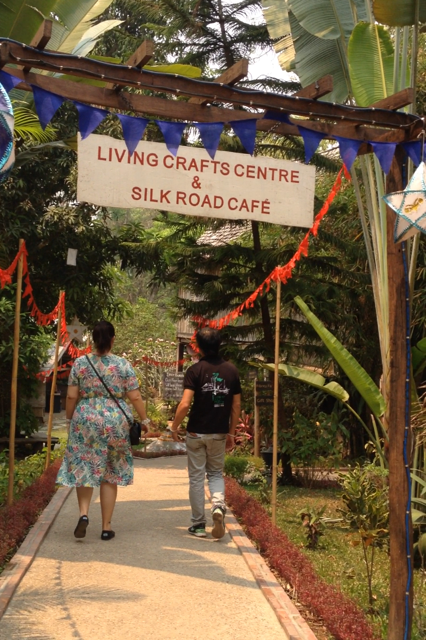
The efforts of Ock Pop Tok over the years resulted in a textile empire and fair trade business that employs and empowers local women through a financial model that supports growth, diversity, and preservation of authentic textile weaving.
Ask your Journeys Within tour consultant about options to include a tour of Ock Pop Tok and weaving classes into your itinerary while visiting Luang Prabang.
After our tour and lunch at Ock Pop Tok, we ventured on to Kuang Si Waterfall, which is over an hour trek by car. We were transported by air-conditioned van, occasionally splashed with water by the local people for the Lao New Year with the traditional water celebrations. Insider tip: If you visit Laos during their New Year, do not drive through town with your windows down-you could get splashed! Also, place your cell phones and other electronic devices in plastic bags to protect them while walking through town.

An added bonus to this tour, we stopped at the Laos location for Free the Bears, Tat Kuang Si Bear Rescue Centre, a sanctuary for Asiatic Black Bears (also known as ‘Moon Bears’). Free the Bears is an organization that rescues and rehabilitates bears that have been abused. The Asiatic Bear population is declining, due primarily to illegal poaching and deforestation. Visitors can see rehabilitated bears from a distance as they play, climb, and sun themselves in their enclosure.
Kuang Si Waterfall is not far from the rescue centre, where visitors enjoy a tree-shaded oasis in one of the many crystal blue pools throughout the area. Visitors can swim, hike, picnic, and lounge at this scenic retreat. The hike in particular offers an exciting excursion for the day, with a half hour trek to the top of the highest waterfall. There are some steep areas on the hike, so mind your steps. Once at the top, visitors may explore the pools in a small boat with a guide. The top of the waterfall is also an opportune vantage point for photos, just remember to be safe and mind the signs.
What to wear for this tour:
Sandals or walking shoes for the city tour, walking shoes for the Kuang Si Waterfall
Hat
Appropriate clothing for giving alms to monks and for visiting temple sites
Sunscreen and insect repellant for the Kuang Si Waterfall
Next up in this series of blogs, we further explore Laos including Phonesavanh, Vientiane, and Paske. See more photos of this journey on our Instagram account: https://www.instagram.com/journeys_within/. Stay tuned to get an insider account of more of our tours!… Read more »




